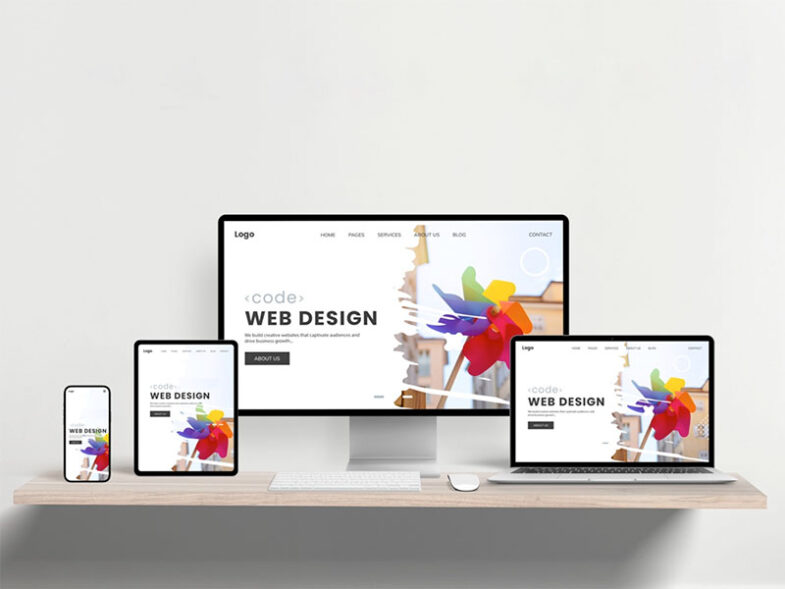A website is often the first point of contact between your business and potential customers. To remain competitive, your website must be visually appealing, functional, and user-friendly. As we enter 2025, emerging design trends are shaping how businesses can stand out online. Let’s explore the essential website design trends you should consider to make a lasting impression.
1. Minimalist and Clean Design
Simplicity is timeless, and in 2025, minimalist design continues to dominate. Clean layouts, ample white space, and streamlined navigation ensure that users can focus on your content without distractions.
Why It Matters:
- Improves readability and user experience.
- Enhances mobile responsiveness.
- Increases website loading speed.
How to Implement:
- Use a clear visual hierarchy to guide users’ attention.
- Limit the use of unnecessary elements and colors.
- Focus on typography and high-quality visuals.
2. Dark Mode and High-Contrast Themes
Dark mode is no longer just a feature; it’s a design standard. High-contrast themes that blend dark backgrounds with vibrant colors create a modern, elegant look that appeals to users across all demographics.
Why It Matters:
- Reduces eye strain in low-light environments.
- Appeals to users’ aesthetic preferences.
- Enhances the visual appeal of multimedia elements.
How to Implement:
- Provide users with the option to toggle between light and dark modes.
- Use accent colors strategically to highlight key elements.
- Ensure readability with appropriate font sizes and contrasts.
3. 3D Visuals and Immersive Design
Three-dimensional visuals and interactive design elements are transforming static websites into engaging experiences. From product showcases to 3D product animation videos and virtual tours, 3D elements offer users a dynamic way to interact with your brand.
Why It Matters:
- Captures attention and enhances user engagement.
- Demonstrates innovation and creativity.
- Provides a competitive edge in saturated markets.
How to Implement:
- Integrate 3D product models for e-commerce.
- Use parallax scrolling for a layered, immersive effect.
- Optimize 3D elements for fast loading times.
4. AI-Driven Personalization
Artificial intelligence (AI) is revolutionizing website design by delivering personalized user experiences. Websites that adapt to individual preferences can increase engagement and drive conversions.
Why It Matters:
- Improves customer satisfaction.
- Enhances retention rates by catering to user needs.
- Encourages repeat visits and loyalty.
How to Implement:
- Use AI tools to analyze user behavior and preferences.
- Display personalized content, product recommendations, or offers.
- Integrate chatbots for instant customer support.
5. Voice Search Optimization
With the rise of voice assistants, optimizing for voice search is essential. Websites designed with voice search in mind prioritize conversational language and quick answers.
Why It Matters:
- Enhances accessibility for users with different needs.
- Aligns with the growing trend of hands-free technology.
- Improves visibility in voice search results.
How to Implement:
- Use long-tail keywords and natural language in your content.
- Structure information with FAQs and concise answers.
- Optimize page speed and mobile usability.
6. Sustainable and Eco-Friendly Design
Sustainability is no longer just a buzzword; it’s a priority for businesses and consumers alike. Websites that reflect eco-conscious values resonate strongly with modern audiences.
Why It Matters:
- Appeals to environmentally conscious consumers.
- Reduces the carbon footprint of your online presence.
- Demonstrates corporate social responsibility.
How to Implement:
- Optimize for energy-efficient hosting solutions.
- Use minimalist coding to reduce resource usage.
- Highlight your sustainability efforts in your design and content.
7. Advanced Micro-Interactions
Micro-interactions—subtle animations or responses to user actions—add a layer of delight and functionality to websites. These can range from a button changing color when hovered over to animated loading icons.
Why It Matters:
- Enhances user engagement and satisfaction.
- Provides instant feedback to user actions.
- Adds a polished, professional touch to your website.
How to Implement:
- Use animations for transitions, clicks, or scrolls.
- Ensure micro-interactions align with your brand identity.
- Keep them subtle and non-intrusive.
8. Professional Stock Photography and Custom Visuals
In 2025, visuals remain a cornerstone of effective website design. High-quality images—whether they’re professional stock photography or custom illustrations—can elevate your brand’s aesthetic and build trust with your audience.
Why It Matters:
- Creates a strong first impression.
- Communicates professionalism and credibility.
- Enhances storytelling and emotional connection.
How to Implement:
- Invest in premium stock photography that aligns with your brand.
- Use custom visuals to highlight unique aspects of your business.
- Optimize images for web performance with compression and proper formatting.
9. Inclusive and Accessible Design
Web accessibility is more than a legal requirement; it’s a best practice for creating an inclusive online experience. Ensuring your website is accessible to all users can broaden your reach and improve usability.
Why It Matters:
- Demonstrates your commitment to inclusivity.
- Enhances usability for everyone, including users with disabilities.
- Improves SEO by meeting technical standards.
How to Implement:
- Use descriptive alt text for all images.
- Provide keyboard navigation and screen reader support.
- Ensure sufficient color contrast and scalable fonts.
The Bottom Line
Website design trends for 2025 focus on creating experiences that are engaging, inclusive, and future-proof. By embracing these trends—from clean layouts and dark mode to AI-driven personalization and professional stock photography—your business can stand out in an increasingly crowded digital landscape. The key is to balance aesthetics with functionality, ensuring your website not only looks great but also delivers exceptional value to your audience.









